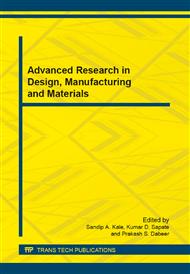p.1
p.9
p.17
p.23
p.29
p.35
p.41
p.51
p.59
Dynamic Stability of a Motorized High Speed Machine Tool Spindle Supported on Bearings
Abstract:
Dynamic behaviour of spindle system influences chatter stability of machine tool considerably. Self-excited vibrations of the tool results in unstable cutting process which leads to the chatter on the work surface and it reduces the productivity. In this paper, a system of coupled spindle bearing system is employed by considering the angular contact ball bearing forces on stability of machining. Using Timoshenko beam element formulation, the spindle unit is analyzed by including the gyroscopic and centrifugal terms. Frequency response functions at the tool-tip are obtained from the dynamic spindle model. In the second phase, solid model of the system is developed and its dynamic response is obtained from three dimensional finite element analysis. The works on analysis of the stability of milling processes focus on calculating the stability boundary of the machining parameters based on the dynamic models characterizing the milling processes. The stability lobe diagrams are generated from frequency response functions (FRF’s) lead to an stability limit prediction for the system at high speed ranges.
Info:
Periodical:
Pages:
29-34
Citation:
Online since:
August 2014
Authors:
Keywords:
Price:
Сopyright:
© 2014 Trans Tech Publications Ltd. All Rights Reserved
Share:
Citation:


